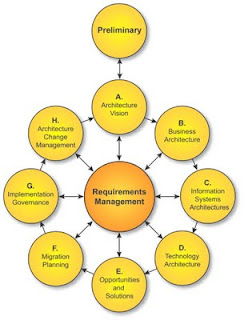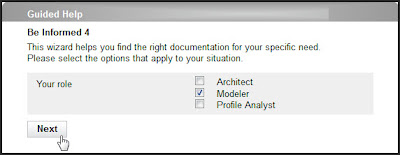Using semantic technology in a model-driven environment
Reaching a smarter form of documentation requires that we start to develop other strategies for displaying knowledge even as we change how we gather and store it. Among the solutions we can offer to accomplish this smarter form of documentation are combinations of non-hierarchical navigation, faceted navigation, decision trees, wizards, and faceted search. But first we have to break our habit of hierarchical structuring all our content in chapters, sections, and subsections. Many web sites, manuals and help systems share this structure: all content elements are sub-themes of an element on the preceding level.
A hierarchical, structured approach is optimized for the most informed users: the developers and designers who created the product. The path it indicates would be the most direct route to becoming an expert user of the product. But for users who need to solve a problem in the immediate term, the structured path may be exactly the wrong path to travel. A customer who wants to complete a specific task without mastering all the aspects of a product would be better served by another approach.
A model-driven approach describes the process of our users, instead of the functionality that they encounter. This more task-based approach offers great advantages, such as delivering a step by step instruction for every activity in the process and on-demand answers to frequently asked questions.
In a traditional – print-centric – approach every single process and all of its exceptions would be grouped together based on formal similarities and displayed in nested outlines, showing broad process categories and allowing users to drill down for more specificity.
Using semantic technology we can combine hierarchical and serial structures into a smart interactive documentation system. It provides us the tools and methods to describe the functionality, processes and context of a system or device in a model. We add meaning to concepts and relations, representing knowledge separately from documents, data and programming code. It gives us the power to create an unlimited amount of access routes to our information, making it possible to create a unique experience for every user.
While semantic technology offers us great possibilities to make our information accessible, it can easily lead to maintenance problems when not handled in the proper way. Using RDF, RDF Schema, XML or other specialized metadata languages, it is – for someone who knows and understands these languages - relatively easy to set up a system that can lead to the desired situation. And as long as the metadata is used in a consistent way, everything seems to work out fine.
But as departments and teams change, the repository of used taxonomies and tags may become unavailable. When the organization rolls out new products, or changes its mission, new content may render today’s schema a relic. Semantic technology provides the resilience that will allow a documentation solution to adapt and endure.
Using any form of code or specialized metadata language in your content will make further development or distribution of the content highly limited. What we need is a solution where we separate the content from the structure and present them both in a way that is understandable for both computers and users.
By using fully model-driven semantic tools, we can express concepts and relations as business models in natural language. Such models are easy to use and maintain and can be linked to various content sources. Modeling domains are used to separate activities from functionality and from context. Linked together and backed up with the content, modeling domains provide us with an overall model for the documentation, which is in fact also the design of our documentation and can instantly be executed as a documentation application. All of this without a single line of code in our content.
 |
| Figure 1. Many web sites, manuals and help systems are build up like a book with chapters, paragraphs and sub-paragraphs |
A hierarchical, structured approach is optimized for the most informed users: the developers and designers who created the product. The path it indicates would be the most direct route to becoming an expert user of the product. But for users who need to solve a problem in the immediate term, the structured path may be exactly the wrong path to travel. A customer who wants to complete a specific task without mastering all the aspects of a product would be better served by another approach.
A model-driven approach describes the process of our users, instead of the functionality that they encounter. This more task-based approach offers great advantages, such as delivering a step by step instruction for every activity in the process and on-demand answers to frequently asked questions.
In a traditional – print-centric – approach every single process and all of its exceptions would be grouped together based on formal similarities and displayed in nested outlines, showing broad process categories and allowing users to drill down for more specificity.
 |
| Figure 2. Describing the process of the users leads – in a traditional setting - to describing every single process and all of its exceptions |
Using semantic technology we can combine hierarchical and serial structures into a smart interactive documentation system. It provides us the tools and methods to describe the functionality, processes and context of a system or device in a model. We add meaning to concepts and relations, representing knowledge separately from documents, data and programming code. It gives us the power to create an unlimited amount of access routes to our information, making it possible to create a unique experience for every user.
Example
The repair center of a large manufacturer of consumer electronics has a group of mechanics servicing customer problems on site. In the past all of these mechanics had the printed service manuals of all products in their car.
Today, the mechanics use notebooks with all service manuals available in PDF. At the customer’s site they simply open their notebook and find the appropriate manual based on the type and serial number of the product. Although the content is digital, the manuals are simply an electronic version of the printed manual and the mechanics still need to find and use the appropriate information within their context. Checklists are used to verify that all needed steps in the repair or service process are followed and all checks have been done.
What if we could combine the checklist and the documentation in one single documentation solution? Think of the impact that this could have on processing time and compliance. By offering the service activity in a process flow, referring to the necessary functional descriptions, we can guide the mechanic through the process and offer the right information at the right time while still offering the possibility to navigate and search through the list of topics.
While semantic technology offers us great possibilities to make our information accessible, it can easily lead to maintenance problems when not handled in the proper way. Using RDF, RDF Schema, XML or other specialized metadata languages, it is – for someone who knows and understands these languages - relatively easy to set up a system that can lead to the desired situation. And as long as the metadata is used in a consistent way, everything seems to work out fine.
But as departments and teams change, the repository of used taxonomies and tags may become unavailable. When the organization rolls out new products, or changes its mission, new content may render today’s schema a relic. Semantic technology provides the resilience that will allow a documentation solution to adapt and endure.
 |
| Figure 3. Example of eRDF mark-up used to express that a device is eligible for an upgrade if it is less than 3 years old and has a specific software version. |
Using any form of code or specialized metadata language in your content will make further development or distribution of the content highly limited. What we need is a solution where we separate the content from the structure and present them both in a way that is understandable for both computers and users.
 |
| Figure 4. Example of a model used to express that a device is eligible for an upgrade if it is less than 3 years old and has a specific software version. |
By using fully model-driven semantic tools, we can express concepts and relations as business models in natural language. Such models are easy to use and maintain and can be linked to various content sources. Modeling domains are used to separate activities from functionality and from context. Linked together and backed up with the content, modeling domains provide us with an overall model for the documentation, which is in fact also the design of our documentation and can instantly be executed as a documentation application. All of this without a single line of code in our content.
Join me at the STC Summit 2013 for an interactive demonstration
As announced earlier, I will demonstrate how we can use semantic
technology to create process-driven documentation at the
STC Summit 2013 in Atlanta. I will do this by
live modeling with a semantic tool set. As the models in the semantic
environment are instantly executable, we can watch the documentation develop, change the models and review the results in a
web browser.
When: May 6th, 2:00 pm (EDT)
Where: Hanover FG, Hyatt Regency Atlanta - Track my session
Level: Advanced
When: May 6th, 2:00 pm (EDT)
Where: Hanover FG, Hyatt Regency Atlanta - Track my session
Level: Advanced
Download the white paper
The white paper “Improve Product and Brand engagement through smart documentation” is available for download on: http://info.beinformed.com/stc13
. This white paper will give you some background information for the
session. Downloading requires an email address, so I can keep you
up-to-date on future developments (there is always an opt-out).


Comments